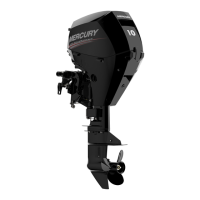GENERAL INFORMATION
eng 25
Pitch ‑ The pitch is the theoretical distance, in inches, that a
propeller travels forward during one revolution. Pitch can be
thought of similar to gears in a car. The lower the gear, the faster
the car will accelerate, but with lower overall top speed.
Likewise, a lower pitch propeller will accelerate quickly, but
top‑end speed will be reduced. The higher the propeller pitch the
faster the boat will usually go; though typically slowing
acceleration.
Determining the Correct Pitch size ‑ First, check the full
throttle RPM under normal load condition. If the full throttle RPM
is within the recommended range, select a replacement or
upgrade propeller with the same pitch as the current propeller.
• Adding 1 inch of pitch will reduce the full throttle RPM by
150 to 200
• Subtracting 1 inch of pitch will increase full throttle RPM by
150 to 200
• Upgrading from a 3‑blade propeller to a 4‑blade propeller
will generally decrease full throttle RPM by 50 to 100
IMPORTANT: Avoid damage to the engine. Never use a
propeller which allows the engine to exceed the recommended
full throttle RPM range when under normal full throttle operation.
PROPELLER MATERIAL
Most propellers manufactured by Mercury Marine are made from
either aluminum or stainless steel. Aluminum is suitable for
general purpose use and is standard equipment on many new
boats. Stainless steel is over five times more durable than
aluminum and typically provides performance gains in
acceleration and top end speed due to design efficiencies.
Stainless steel propellers also come in a larger variety of sizes
and styles that allow you to dial in the ultimate performance for
your boat.

